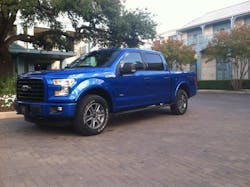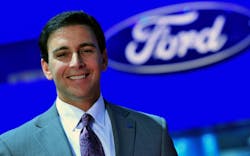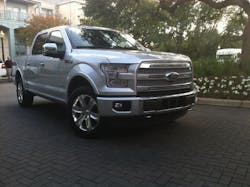Now, though, Ford’s bet on this new pickup is getting even bigger as OEM adjusts its fiscal sails in the face of some near-term headwinds.
In a conference call with reporters this week, Mark Fields – Ford’s president and CEO – laid out what he dubbed the company’s “2020 vision,” which includes plans to substantially increase its global vehicle sales and automotive operating margin, and achieve more “balanced” geographic profitability.
While Fields said Ford projects to generate “positive automotive operating-related cash flow” throughout the next six years – with capital spending expected to increase to about $9 billion annually, up from $6.6 billion in 2013 – higher than expected warranty costs and losses in two key overseas markets are generating some near-term bumps in the OEM’s fiscal road.
Fields explained during the conference that Ford expects to report pretax profit this year of between $6 billion and $7 billion, approximately $1.5 billion less than the OEM forecast back in July, with nearly $1 billion in warranty and recall costs the main culprit for the profitability pullback.
One top of that, losses in the Russia and South American markets – estimated at $300 million and $900 million, respectively – created fiscal challenges for the automaker this year.Still, Fields (seen at left) pointed out that better-than-expected unit volumes and pricing – especially in North America – helped offset some of those shortfalls.
Overall, Ford now expects its North American operating margin at the lower end of its 8% to 9% guidance range, and better results in Europe, Asia Pacific and Ford Credit, compared to 2013.
This year is also “a critical building block” from another perspective, Fields noted, as Ford remains “on plan” to launch a record 23 vehicles in preparation for a more profitable 2015.
By 2015, the OEM said it expects to realize the benefits of its global product investment and growth strategies, launching another 16 global vehicles and expecting pre-tax profits, excluding special items, to be significantly higher — in the $8.5 billion to $9.5 billion range — with all five of its automotive regions improving on 2014 results.
Europe will remain a sore spot for Ford, though, as while it expected that region to return to profitability in 2015, it is now expected to lose about $250 million because of continued volatility in Russia and higher pension expenses as a result of lower interest rates.
“In 2015, we’ll take the next step in our long-term plan that calls for all parts of the Ford business to contribute to overall profitability,” noted Bob Shanks, Ford’s executive VP and CFO, on the call. “Although we face a variety of challenges as we approach 2015, we are well positioned for long-term growth in all areas of the business.”Revenue and operating margin are projected to be higher in 2015 compared to 2014, though, with wholesale volume is expected to grow in all regions.
Overall, Ford expects industry sales volumes to grow in 2015, with U.S. industry sales ranging between 16.8 million and 17.5 million units. In Europe, sales are expected between 14.8 million and 15.3 million units, while in China, they are expected to increase to between 24 million and 26 million units, the OEM said.
By 2020, though, Fields noted that Ford projects annual global sales to increase 45% to 55 % to approximately 9.4 million units, with its automotive operating margin forecast to improve to about 8% over that six-year period, with a long-term target of 8% to 9%.
“Our long-term plan underscores the commitment we have to our One Ford plan, while accelerating our pace of progress, delivering product excellence and driving innovation in all areas of our business,” Fields stressed. “We remain completely focused on offering customers the freshest lineup of world-class vehicles to meet their needs.”
He pointed out, too, that Ford remains “on plan” to have 99% of its global sales volume built on nine platforms by 2016 and is furthering its strategy by consolidating its long-term product plan to eight platforms.
Fields added, too, that Ford anticipates that, by 2020, all five of its automotive business units as well as Ford Credit will contribute to its profitability. Today, the company’s profits come largely from North America and Ford Credit, with growing profits in Asia Pacific, while it continues transforming its Europe, South America and Middle East & Africa operations.
In addition, by 2020, the company projects its breakeven volume will be two-thirds of its wholesale volume, with vehicle designs “targeted” towards a more “diverse set of customers,” from value buyers in developing regions to luxury customers in the U.S. and China and truck and utility customers globally.One interesting portent Ford highlighted in its sales call: a shift in customer and regional trends that will give small vehicles a larger role in the OEM’s product portfolio.
Global models like the Fiesta, Focus and EcoSport (seen at left), and regional nameplates such as the Figo, Ka and Escort, will comprise a greater percentage of Ford’s sales, Fields noted, with more fuel-efficient and versatile sport utility vehicles (SUVs) and crossovers, like the Edge and Explorer, making up a larger portion of Ford’s overall sales total: especially as those models become available in new regions.
That’s a pretty busy game plan the Blue Oval is putting into play, to say the least, and it’s starting with the new aluminum-forged F-150. We’ll see how customers react to all of it in the months ahead.




